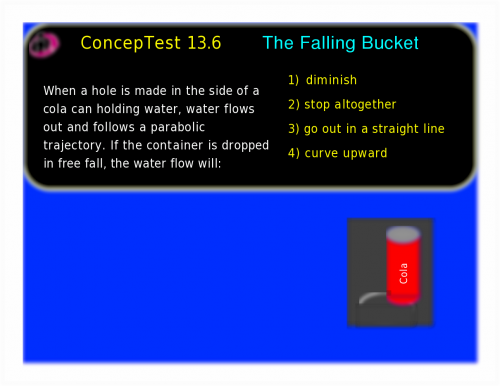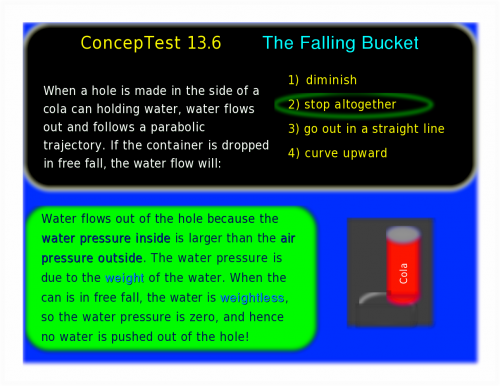Peer instruction is a form of collaborative learning where students engage with core course concepts and then explain those concepts to one another. Crouch and Mazur (2001) note that "unlike the common practice of asking informal questions during a lecture, which typically engages only a few highly motivated students, the more structured questioning process of [peer instruction] involves every student in the class" (p. 970).
In order to be effective, peer instruction must be thoughtfully choreographed by the instructor. Typically, discussions are centred on a question whose answer requires application of a principle or concept that is fundamental to the course content. After students engage in peer-based discussion, the instructor debriefs with the students, to clarify or correct any remaining issues.
Peer instruction may mean different things to different instructors and within different disciplines. In this teaching tip, the focus is on one approach to peer instruction developed by Eric Mazur often associated with "ConceptTests."
Why peer instruction works
Students become more invested
Asking students to choose a response to a question gets them more emotionally engaged with the content. They care more about the outcome. By way of analogy, imagine that two people — David and Zara — are not really interested in hockey, and yet they somehow end up at a game. If they simply observe the hockey game, they will not feel very involved with it, and probably won't be able to recall the outcome of the game a week later. However, if David suddenly decides to root for the team wearing red, and Zara decides to root for the team wearing blue, then their level of emotional engagement immediately increases: they will start to care about the outcome, and will probably watch the game more closely. In short, students become more engaged when they are asked to make a choice, and this effect is multiplied when their peers around them are making the same choice (Crouch, Watkins, Fagen, & Mazur, 2007).
Students engage in genuine teaching
Skeptics might suggest that during peer instruction the "stronger" student in the pair or group simply tells the other students the correct answer, which they then also select. However, studies show that this is not the case. Typically, these studies have students engage in peer instruction as described above. They then have the students respond to new questions, ones that require the students to apply the concept to a different situation. The students do better on these new questions after the original peer instruction. In other words, they have actually taught and learned from one another (Smith et al., 2009; Porter, Lee, Simon, & Zingaro, 2011).
Students bring a needed "novice" perspective
As Eric Mazur has pointed out, students are sometimes more adept at explaining things to one another than the instructor is. Instructors sometime suffer from "expert bias," which is the state of knowing a subject so thoroughly that you can no longer imagine the conceptual difficulties that confront a novice in the subject. Or, as Mazur says, the instructor "has lost the ability to understand what a beginning learner faces" (qtd. in Lambert, 2012).
Understanding can improve even if the correct answer isn't reached
Students who have experienced peer instruction have spoken to its other benefits (Porter et al., 2011), including:
- "Even if nobody knows the answer, each person might know different pieces of the answer that, together, could lead the group to the right answer."
- "There were a number of times that our group reached a wrong conclusion, but the discussion itself resulted in a better understanding of the relevant concepts."
- "When people are throwing around ideas, you learn different approaches to a problem."
Step 1: Set the stage
- Introduce a concept — usually a seven- to ten-minute lecture will suffice.
- Give the students a minute or two to respond individually to a multiple-choice question that requires application of the concept. The multiple-choice question is presented with four possible answers, identified as "A," "B," "C," or "D."
- Tally up the responses of the students. This can be done in several ways:
- Simply ask students to hold up their hands: "Raise your hand if you chose 'A'. Raise your hand if you chose 'B'"... and so on.
- Having provided each student with four coloured cards, with the red card representing "A," the blue card representing "B," and so on, students hold up the card that corresponds to their answer. A glance will give you a rough sense of the distribution of the answers.
- Use clickers or an app such as PollEverywhere to tally the responses (and to display a bar graph of responses).
Step 2: Turn it over to students
- Ask each student to find a nearby classmate who chose a different answer than the one they chose. They then have two to four minutes to try to convince their classmate of their answer. Students can also do this in groups of three.
- Ask the students to take another minute or so to respond again to the question that preceded the discussion. They are allowed to change their answer if they want to.
- Tally up the new responses. Typically, more students will have chosen the correct answer. If, say, 90% of the students have now chosen the correct answer, then the instructor will probably spend a few minutes reviewing the concept (along with the question and answer) and then move on to the next chunk of course content. If a significant percentage of students still chose the incorrect answer, then the instructor will probably choose to spend more time on the material, to address the lack of understanding.
Creating good peer-instruction questions
The multiple-choice questions that are central to Peer Instruction are sometimes referred to as "ConceptTests." As noted above, these questions should focus on key concepts pertaining to the course content. They should not be fact-based questions, but rather should focus on requiring the students to apply or explore a recently taught concept. Eric Mazur suggests that the multiple-choice questions should:
- Focus on a single important concept, ideally corresponding to a common student difficulty.
- Require genuine thought, not just plugging numbers into equations.
- Have a single correct answer, but the other answers (the incorrect ones) should seem plausible or should reflect a misunderstanding often made by students.
- Be worded in a clear and direct manner.
- Be neither too easy nor too difficult.
ConceptTest sample question: The Falling Bucket
The following example of a ConceptTest question and answer comes from a physics course.
Question: When a hole is made in the side of a cola can holding water, water flows and follows a parabolic trajectory. If the container is dropped in free fall, the water will:
- diminish
- stop altogether
- go out in a straight line
- curve upward

In this example, the correct answer is shown beside the question for clarity, and a brief explanation of the answer is provided.

Support
If you would like support applying these tips to your own teaching, CTE staff members are here to help. View the CTE Support page to find the most relevant staff member to contact.
References
- Crouch, C. H., & Mazur, E. (2001). Peer instruction: Ten years of experience and results. American Journal of Physics, 69(9), 970-977.
- Crouch, C. H., Watkins, J., Fagen, A. P., & Mazur, E. (2007). Peer instruction: Engaging students one-on-one, all at once. Research-Based Reform of University Physics, 1.
- Lambert, C. (March-April 2012). Twilight of the lecture. Harvard Magazine.
- Porter, L., Lee, C. B., Simon, B., & Zingaro, D. (2011). Peer instruction: Do students really learn from peer discussion in computing? Proceedings of the Seventh International Workshop on Computing Education, pp. 45-52.
- Smith, M. K., Wood, W. B., Adams, W. K., Wieman, C., Knight, J. K., Guild, N., & Su, T. T. (2009). Why peer discussion improves student performance on in-class concept questions. Science, 323(5910), 122-124.
Resources
CTE teaching tips
Other resources
- Mazur, Eric. Interactive Teaching. An eight-minute video in which Eric Mazur, the developer of Peer Instruction, explains its basics.
- Mazur, Eric. Confessions of a Converted Lecturer. An 80-minute video presentation on Peer Instruction by Eric Mazur, its developer.
- Mazur, Eric. Peer Instruction: Getting Students to Think in Class.
This Creative Commons license lets others remix, tweak, and build upon our work non-commercially, as long as they credit us and indicate if changes were made. Use this citation format: Peer Instruction and Concept Tests. Centre for Teaching Excellence, University of Waterloo.